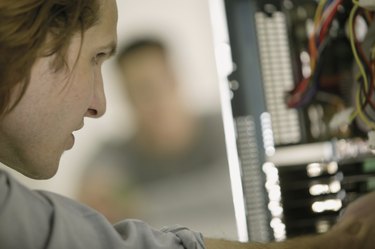
Cards slots inside desktop computers are used to install new and upgraded hardware components. But before you can install a new video card, sound card, or other component you must be sure that the PCI card slots themselves are functioning normally. Card slot problems also account for the failure of many current components inside your machine. There are ways to check for PCI slots without resorting to special tools and testing devices.
Hardware Device Manager
Video of the Day

You can check for PCI card problems by going to Start/ControlPanel/System and clicking on "Device Manager." Device Manager will provide a list of all the hardware components in your machine. If there is a problem with any of these devices, there will be a yellow triangle with an exclamation mark, or a red "x," over the device listing. Click on this listing and see what may be reported to be wrong. If the device is not listed at all, it is almost certain that either the component itself is broken, the driver for the component is missing, or the PCI slot itself is no longer functioning.
Video of the Day
A Process of Elimination

To determine if the PCI card device itself is bad, move the card to another slot. Turn off your computer, unplug all the cables (to prevent accidental shorting), and open the case. Remove the PCI card from the slot that is troubled and insert it into another compatible PCI slot. Restore the cables and reboot the machine. Install any necessary drivers for the device. Now check the Device Manager to see if the device is registering correctly. If the same device works in this new slot, it is probable that the other PCI slot is malfunctioning. Further test this theory by installing another known-good device in the questionable slot. If this device also will not work, the PCI slot itself is almost certainly bad.
Check the Motherboard BIOS

Motherboards and processors operate with the help of a Basic Input Output System (BIOS) program and sub-programs that assist the motherboard chipsets in managing devices on the motherboard. These programs are damaged in some circumstances and also need to be updated occasionally. You can try to restart a failing PCI slot by "flashing" or updating your BIOS and chipset files. Navigate to your computer maker's website and look for downloads for the BIOS and chipsets for your model. If none are available, go to the website of the motherboard manufacturer: all motherboards have product identifications that are easily searched online. Download these files and install them. After flashing the BIOS/chipsets, test the PCI card slot again. If the slot still will not function, it is likely that the PCI slot circuit has been permanently damaged.
Device Drivers

Before concluding testing on a PCI slot, always consider that the driver for the device in question may not be correct. Drivers for items like video, sound, ethernet, and other cards are finicky: the driver must be an exact match for the device and the operating system you are using. Check with the manufacturer of the PCI device for the latest drivers.